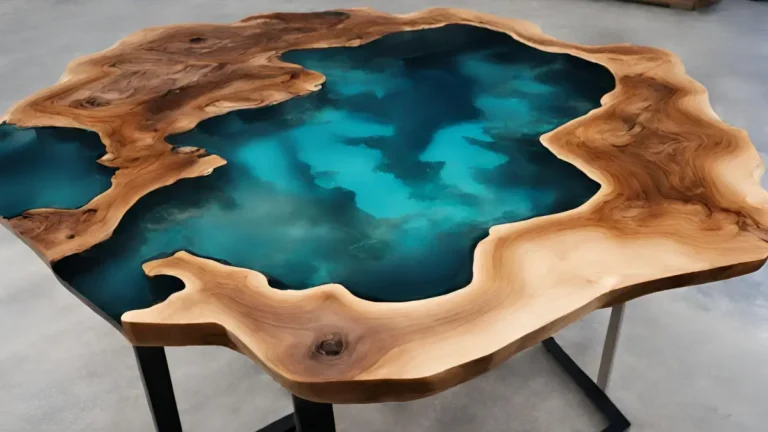
How to Resin Table Top
Choosing the Right Table
When it comes to resin coating a table top, the first step is to choose the right table. Make sure that the table is sturdy and flat, as any imperfections will show through the resin. Wooden tables are the most common choice for resin coating, but you can also use glass, metal, or even concrete tables.
Gathering Materials and Prep Work
Before you start the resin coating process, make sure you have all the necessary materials. You will need epoxy resin, hardener, a mixing cup, stir sticks, gloves, a drop cloth, and a heat gun or torch for removing air bubbles. Begin by sanding and cleaning the table to ensure a smooth surface for the resin to adhere to.
Mixing and Applying the Resin
Follow the instructions on the resin packaging to mix the resin and hardener thoroughly. Pour the resin mixture onto the table top, using a spreader tool to ensure even coverage. Use the heat gun or torch to remove any air bubbles that may have formed. Allow the resin to cure according to the manufacturer’s instructions.
Additional Coats and Finishing Touches
Depending on the desired thickness and finish, you may need to apply multiple coats of resin. Sanding between coats can help achieve a smooth and level surface. Once the final coat has cured, you can add any additional touches such as color pigments or metallic flakes for a unique look. Finish off with a clear top coat for added protection.
How to Resin Table Top
Resin coating a table top is a fun and creative DIY project that can transform an ordinary piece of furniture into a stunning work of art. By following these step-by-step instructions, you can achieve a professional-looking finish that will impress all your friends and family. So why wait? Grab your materials and get started on resin coating your table top today!
Read the Recent Articles of the Day by Clicking Here!
When working on a resin table top, it is essential to carefully follow the steps to ensure a beautiful and professional finish. Here is a step-by-step guide to help you achieve stunning results:
1. Prepare the surface: Begin by thoroughly cleaning and sanding the surface of the table to remove any dirt, imperfections, or previous finishes. Make sure the surface is smooth and free of any debris.
2. Seal the edges: To prevent the resin from leaking over the edges of the table, seal the edges with a clear packing tape or silicone caulk. This will create a barrier to contain the resin and ensure a clean finish.
3. Mix the resin: Following the manufacturer’s instructions, mix the resin and hardener together in a clean container. Stir the mixture thoroughly for several minutes to ensure it is well combined.
4. Pour the resin: Carefully pour the mixed resin onto the table surface, starting in the center and working outward. Use a spreader or brush to evenly distribute the resin, ensuring it covers the entire surface evenly.
5. Remove bubbles: To remove any bubbles that may have formed in the resin, use a heat gun or torch to gently heat the surface. This will help the bubbles rise to the top and pop, resulting in a smooth finish.
6. Add color or effects (optional): If desired, you can add color pigments, glitter, or other effects to the resin to create a unique and personalized look. Mix these additives into the resin before pouring it onto the table.
7. Allow to cure: Allow the resin to cure according to the manufacturer’s instructions. This usually takes 24-48 hours, depending on the type of resin used. Make sure to cover the table to protect it from dust and debris while it cures.
8. Sand and finish: Once the resin has cured, sand the surface lightly to remove any imperfections or rough spots. Apply a final coat of resin or a clear sealer to protect the surface and give it a glossy finish.
Following these steps will help you achieve a stunning DIY resin table top that will impress your friends and family. Enjoy the process and the finished product!

Frequently Asked Questions: How to resin table top
What materials do I need to resin a table top?
To resin a table top, you will need epoxy resin, a mixing container, stirring sticks, gloves, a heat gun, a torch for bubbles, and a level surface to work on.
Can you resin over existing finishes on a table top?
Yes, you can resin over existing finishes on a table top as long as you properly prepare the surface by sanding and ensuring it is clean and dry beforehand.
How long does it take for resin to cure?
The curing time of resin depends on the type of resin used, but it typically takes anywhere from 24 hours to several days for it to fully cure.
How can I avoid air bubbles when applying resin?
To avoid air bubbles when applying resin, you should mix the resin slowly to minimize air entrapment, use a heat gun or torch to remove bubbles, and work in a warm environment.
So, what do you think about this subject? Share your opinion in the comments and let’s continue discussing together!


